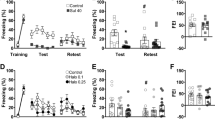Abstract
The purpose of this study was to determine if non-pharmacological stimuli influence behavioral tolerance to haloperidol via striatal postsynaptic dopamine receptors. Rats received daily haloperidol and saline in two different environments for a period of 28 days. After this conditioning period half of the rats received haloperidol in the haloperidol-associated environment, whereas the other half received haloperidol in the saline-associated environment. All rats were tested for catalepsy and at the end of the last catalepsy test, striatal DOPAC, HVA and ACh were determined. Only the rats tested in the haloperidol-associated environment were behaviourally tolerant to haloperidol. In contrast, both groups were biochemically tolerant to haloperidol.
These results indicate that environmental cue factors govern the development of behavioural tolerance to haloperidol, rather than biochemical factors (striatal DA supersensitivity). In addition, these factors do not exert their influence on behavioural tolerance via striatal DA receptors.
Similar content being viewed by others
References
Asper A, Bagglioni M, Burki HR, Lauener H, Ruch W, Stille G (1973) Tolerance phenomena with neuroleptics catalepsy, apomorphine stereotypies and striatal dopamine metabolism in the rat after single and repeated administration of loxapine and haloperidol. Eur J Pharmacol 22:287–294
Ayd FJ (1971) Neuroleptics and antiparkinson drugs. Int Drug Ther New Lett 6:33–36
Bannon MJ, Reinhard JF Jr, Bunney BS, Roth RH (1982) Unique response to antipsychotic drugs is due to absence of terminal autoreceptors in mesocortical dopamine neurones. Nature 296:444–446
Costall B, Olley JE (1971) Cholinergic- and neuroleptic-induced catalepsy: modification by lesions in the caudate-putamen. Neuropharmacology 10:297–306
Damsma G, Westerink BHC, Horn AS (1985) A simple, sensitive and economic assay for choline and acetylcholine using HPLC, an enzyme reactor, and a electrochemical detector. J Neurochem 45:1649–1652
Dimascio A, Demirgian E (1970) Antiparkinson drug overuse. Psychosomatics 11:596–601
Ebstein R, Pickholz D, Belmaker RH (1979) Dopamine receptor changes after long-term haloperidol treatment in rats. J Pharm Pharmacol 31:558–559
Ezrin-Waters C, Seeman P (1977) Tolerance to haloperidol catalepsy. Eur J Pharmacol 41:321–327
Fog R (1972) On stereotypy and catalepsy: studies on the effects of amphetamines and neuroleptics in rats. Acta Neurol Scand Suppl 50:3–66
Hartgraves SL, Kelly PH (1984) Role of mesencephalic reticular formation in cholinergic-induced catalepsy and anticholinergic reversal of neuroleptic-induced catalepsy. Brain Res 307:47–54
Hinson RE, Siegel S (1982) Nonpharmacological bases of drug tolerance and dependence. J Psychosom Res 26:495–503
Janssen PA, Niemegeers CJ, Schellekens KH (1965) Is it possible to predict the clinical effects of neuroleptic drugs (major tranquillizers) from animal data? Arzneim Forsch 15:104–117
Koffer KB, Berney S, Hornykiewicz O (1978) The role of the corpus striatum in neuroleptic- and narcotic-induced catalepsy. Eur J Pharmacol 47:81–86
Korf J, Sebens JB (1986) Relation between dopamine receptor occupation by spiperon and acetylcholine levels in the rat striatum after long term haloperidol treatment. J Neurochem (in press)
Korf J, Sebens JB, Flentge F, Van der Werf JF (1985) Occupation of dopamine receptors by N-n-propylnorapomorphine or spiperone and acetylcholine levels in the rat striatum. J Neurochem 44:314–318
Meller E, Friedhoff AJ, Friedman E (1980) Differential effects of acute and chronic haloperidol treatment on striatal and nigral 3,4-dihydroxyphenylacetic acid (DOPAC) levels. Life Sci 26:541–547
Poulos CX, Hinson R (1982) Pavlovian conditional tolerance to haloperidol catalepsy: evidence of dynamic adaptation in the dopaminergic system. Science 218:491–492
Puri SK, Lal H (1974) Tolerance to the behavioural and neurochemical effects of haloperidol and morphine in rats chronically treated with morphine or haloperidol. Naunyn-Schmiedeberg's Arch Pharmacol 282:155–170
Sanberg PR (1980) Haloperidol-induced catalepsy is mediated by postsynaptic dopamine receptors. Nature 284:472–473
Scatton B, Dedek J, Korf J (1977) Effect of single and repeated administration of haloperdiol and sulpiride on striatal and retinal dopamine turnover in the rat. Brain Res 135:374–377
Scatton B (1981) Differential changes in DOPAC levels in the hippocampal formation, septum and striatum of the rat induced by acute and repeated neuroleptic treatment. Eur J Pharmacol 71:499–503
Seeger TF, Thal L, Garnder EL (1982) Behavioural and biochemical aspects of neuroleptic-induced dopaminergic supersensitivity: studies with chronic clozapine and haloperidol. Psychopharmacology 76:182–187
Seeman P (1980) Brain dopamine receptors. Pharmacol Rev 32:229–313
Sethy VH (1976) Effects of chronic treatment with neuroleptics on striatal acetylcholine concentration. J Neurochem 27:325–326
Siegel S (1956) Non-parametrical statistics for behavioural sciences. McGraw-Hill, Tokyo
Siegel S (1976) Morphine analgesic tolerance: its situation specificity supports a pavlovian conditioning model. Science 193:323–325
St Jean A, Donald M, Ban TA (1964) Interchangeability of antiparkinson medication. Am J Psychiat 120:1189–1190
Westerink BHC, Mulder TBA (1981) Determination of picomole amounts of dopamine, noradrenaline, 3,4-dihydroxyphenylalanine, 3,4-dihydroxyphenylacetic acid, homovanillic acid 5-hydroxyindolacetic acid in nervous tissue after one step purification on Sephadex G-10, using high performance liquid chromatography with a novel type of electrochemical detection. J Neurochem 36:1449–1462
Worms P, Willigens MT, Continsouza-Blanc D, Lloyd KG (1985) The effect of different types of cortical lesions on drug-induced catalepsy in rats: a pharmacological analysis. Eur J Pharmacol 113:53–59
Author information
Authors and Affiliations
Rights and permissions
About this article
Cite this article
de Graaf, C.J., Korf, J. Conditional tolerance to haloperidol-induced catalepsy is not caused by striatal dopamine receptor supersensitivity. Psychopharmacology 90, 54–57 (1986). https://doi.org/10.1007/BF00172871
Received:
Revised:
Issue Date:
DOI: https://doi.org/10.1007/BF00172871




